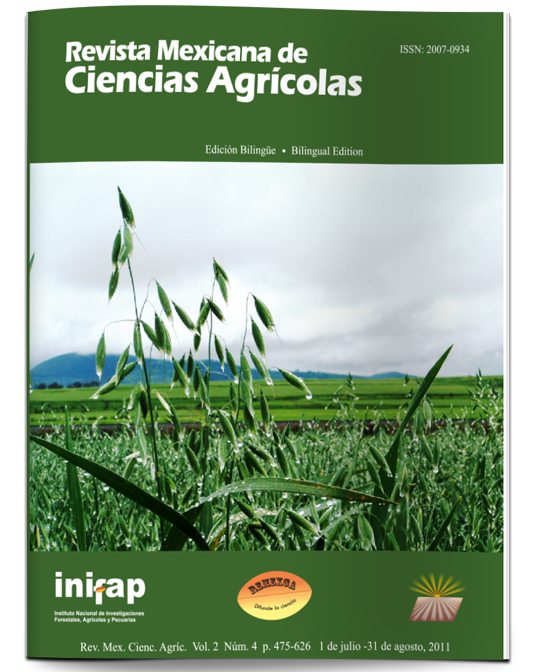PHENOLOGY, PLANT GROWTH AND FLORAL SYNCHRONY OF THE PARENTAL LINES OF H-374C QPM MAIZE HYBRID
DOI:
https://doi.org/10.29312/remexca.v2i4.1635Keywords:
Zea mays L., degree days of development, growth analysis, phenological stages, parentsAbstract
The temperature is a climatic parameter with the greatest influence on plants physiology; on the other hand, in maize (Zea mays L.) seed production, phenological characterization of progenitors based on heat units, defines the exact date of planting to achieve floral synchrony in hybrids formation. The objective of this research was to study the effect of temperature on growth and development stages of the trilinear hybrid progenitors of maize QPM H-374C, which determine the flower matching and seed production. The genetic material used was: the single-cross female parent (CML 176∗CML 142), their inbred lines progenitor (CML 176 and CML 142) and inbred line CML 186, male parent of H-374C. The research was conducted under irrigation during the spring-summer 2007 in Celaya, Guanajuato, Mexico. A randomized complete block design with three replications was used. The phenological stages determined with the residual method, were: f loral differentiation, tasseling, male and female flowering and physiological maturity. For growth analysis dry matter samples were taken weekly, when the plant showed four ligulated leaves and until physiological maturity. It was observed that simple cross was precocious to flowering with respect to parental lines, but the grain filling stage was longer. Floral synchrony between female parent (CML 176∗ CML 142) and male parent (CML 186) was high, while in order to form the single-cross CML 176∗CML 142, the female parent required 30 degree days of development (two days) more than the male parent to silking. The single-cross female parent expressed heterosis in leaf area, biomass, leaf area index and leaf area duration. This vigor and prolonged grain filling period reflected higher seed yield.
Downloads
Downloads
Published
How to Cite
Issue
Section
License
The authors who publish in Revista Mexicana de Ciencias Agrícolas accept the following conditions:
In accordance with copyright laws, Revista Mexicana de Ciencias Agrícolas recognizes and respects the authors’ moral right and ownership of property rights which will be transferred to the journal for dissemination in open access. Invariably, all the authors have to sign a letter of transfer of property rights and of originality of the article to Instituto Nacional de Investigaciones Forestales, Agrícolas y Pecuarias (INIFAP) [National Institute of Forestry, Agricultural and Livestock Research]. The author(s) must pay a fee for the reception of articles before proceeding to editorial review.
All the texts published by Revista Mexicana de Ciencias Agrícolas —with no exception— are distributed under a Creative Commons License Attribution-NonCommercial 4.0 International (CC BY-NC 4.0), which allows third parties to use the publication as long as the work’s authorship and its first publication in this journal are mentioned.
The author(s) can enter into independent and additional contractual agreements for the nonexclusive distribution of the version of the article published in Revista Mexicana de Ciencias Agrícolas (for example include it into an institutional repository or publish it in a book) as long as it is clearly and explicitly indicated that the work was published for the first time in Revista Mexicana de Ciencias Agrícolas.
For all the above, the authors shall send the Letter-transfer of Property Rights for the first publication duly filled in and signed by the author(s). This form must be sent as a PDF file to: revista_atm@yahoo.com.mx; cienciasagricola@inifap.gob.mx; remexca2017@gmail.
This work is licensed under a Creative Commons Attribution-Noncommercial 4.0 International license.



